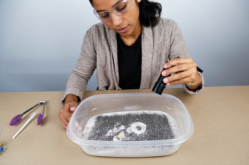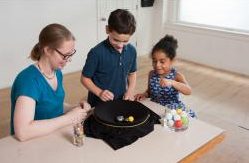Hands-on activities
Planetary Geology
A Teacher's Guide with Activities in Physical and Earth Sciences
Grades 5 to college
Guide and activity book published by NASA, covering topics from impact cratering to planetary mapping. Each activity has separate instructor's notes and student work pages.
http://lroc.sese.asu.edu/files/EducatorGuides/Planetary.Geology.pdf
Exploring the Solar System: Asteroid Mining
Ages 4 to adult
 In this activity, participants will imagine the challenges and opportunities of asteroid mining. Participants will draw their own asteroid mining machines, and consider how these devices would extract, process, and return mined materials to Earth.
In this activity, participants will imagine the challenges and opportunities of asteroid mining. Participants will draw their own asteroid mining machines, and consider how these devices would extract, process, and return mined materials to Earth.
While the technologies necessary for mining materials from asteroids do not yet exist, current missions exploring and studying asteroids may lay the groundwork for future asteroid mining operations.
https://www.nisenet.org/catalog/exploring-solar-system-asteroid-mining-2020
[expand title=”National Informal STEM Education Network” tag=”u” trigclass=”arrowright” targclass=”div”]In collaboration with NASA, the National Informal STEM Education (NISE) Network have assembled a new set of engaging, hands-on Earth and space science experiences with connections to science, technology, and society, as well as tips for leading hands-on activities.
NISE Network products are developed through an iterative collaborative process that includes scientific review, peer review, and visitor evaluation in accordance with an inclusive audiences approach. Products are designed to be easily edited and adapted for different audiences under a Creative Commons Attribution Non-Commercial Share Alike license. To learn more, visit the NISE Development Process page.[/expand]
Exploring the Solar System: Craters
Ages 4 to adult
 An active, hands-on activity that demonstrates how craters form, and what they can teach us about the history and composition of planets and moons. By dropping objects of various sizes and shapes into a tub full of sand and other materials, participants simulate the formation of a meteorite crater, and then study the craters using special tools. Scientists use similar methods to study the geological processes on other planets, moons, and asteroids.
An active, hands-on activity that demonstrates how craters form, and what they can teach us about the history and composition of planets and moons. By dropping objects of various sizes and shapes into a tub full of sand and other materials, participants simulate the formation of a meteorite crater, and then study the craters using special tools. Scientists use similar methods to study the geological processes on other planets, moons, and asteroids.
https://www.nisenet.org/catalog/exploring-solar-system-craters-2018
[expand title=”National Informal STEM Education Network” tag=”u” trigclass=”arrowright” targclass=”div”]In collaboration with NASA, the National Informal STEM Education (NISE) Network have assembled a new set of engaging, hands-on Earth and space science experiences with connections to science, technology, and society, as well as tips for leading hands-on activities.
NISE Network products are developed through an iterative collaborative process that includes scientific review, peer review, and visitor evaluation in accordance with an inclusive audiences approach. Products are designed to be easily edited and adapted for different audiences under a Creative Commons Attribution Non-Commercial Share Alike license. To learn more, visit the NISE Development Process page.[/expand]
Exploring the Universe: Orbiting Objects
Ages 4 to adult
 A hands-on activity that invites participants to experiment with different sized and weighted balls on a stretch fabric gravity well. The activity models gravitational attraction in space. Participants investigate how changing conditions can cause phenomena like stellar wobble and planet formation.
A hands-on activity that invites participants to experiment with different sized and weighted balls on a stretch fabric gravity well. The activity models gravitational attraction in space. Participants investigate how changing conditions can cause phenomena like stellar wobble and planet formation.
https://www.nisenet.org/catalog/exploring-universe-orbiting-objects
[expand title=”National Informal STEM Education Network” tag=”u” trigclass=”arrowright” targclass=”div”]In collaboration with NASA, the National Informal STEM Education (NISE) Network have assembled a new set of engaging, hands-on Earth and space science experiences with connections to science, technology, and society, as well as tips for leading hands-on activities.
NISE Network products are developed through an iterative collaborative process that includes scientific review, peer review, and visitor evaluation in accordance with an inclusive audiences approach. Products are designed to be easily edited and adapted for different audiences under a Creative Commons Attribution Non-Commercial Share Alike license. To learn more, visit the NISE Development Process page.[/expand]
Lunar & Meteorite Sample Disk Program
Grades K-12
Intended for K-12 classrooms, or qualified museums and libraries. In order to be elegible to receive the Sample Disks, a user must be employed (receiving a paycheck) by one of the above learning institutions. Educators must be certified to borrow the Lunar and Meteorite Sample Disks by attending a NASA Certification Workshop provided by a NASA Authorized Sample Disk Certifier.
https://ares.jsc.nasa.gov/interaction/lmdp/
Impact Craters
Grades 4-12
Impact craters are formed when impactors such as meteorites smash into the Moon's surface. Explore the many factors that affect the appearance of impact craters, including the size and velocity of the impactor, and the geology of the surface.
https://www.nasa.gov/audience/foreducators/topnav/materials/listbytype/Impact_Craters.html
Collecting Micrometeorites
Grades K-12
 Find out where to look and how to collect tiny micrometeorites that fall to Earth and accumulate in your backyard.
Find out where to look and how to collect tiny micrometeorites that fall to Earth and accumulate in your backyard.
https://icecube.wisc.edu/outreach/activity/micrometeorites
Space Rocks! A Meteorite Board Game
Ages 9-14
 This board game reinforces children's understanding of the origins of meteors, meteoroids, and meteorites, as well as their characteristics and importance, while tackling some common misconceptions about these space rocks.
This board game reinforces children's understanding of the origins of meteors, meteoroids, and meteorites, as well as their characteristics and importance, while tackling some common misconceptions about these space rocks.
https://www.lpi.usra.edu/education/skytellers/meteors/activities/space_rocks.shtml
Family Space Days
 Family Space Day is a three hour event. The activities are set up so that children and parents can select the order in which they undertake activities. Parents and
Family Space Day is a three hour event. The activities are set up so that children and parents can select the order in which they undertake activities. Parents and
children are encouraged to learn, play, and explore together.
https://www.lpi.usra.edu/education/space_days/activities/spaceRocks/
Crater Creations: Moon
Ages 8-13
 In this 30–45-minute activity, teams of children experiment to create impact craters and examine the associated features. The children observe images of lunar craters and explore how the mass, shape, velocity, and angle of impactors affects the size and shape of the crater.
In this 30–45-minute activity, teams of children experiment to create impact craters and examine the associated features. The children observe images of lunar craters and explore how the mass, shape, velocity, and angle of impactors affects the size and shape of the crater.
https://www.lpi.usra.edu/education/explore/LRO/activities/craterCreations/
The Lunar and Planetary Institute's Explore program is designed to engage children in Earth and space science in out-of-school time, library, and informal science education programs. Library staff across the country are using the activities to bring new audiences into the library.
